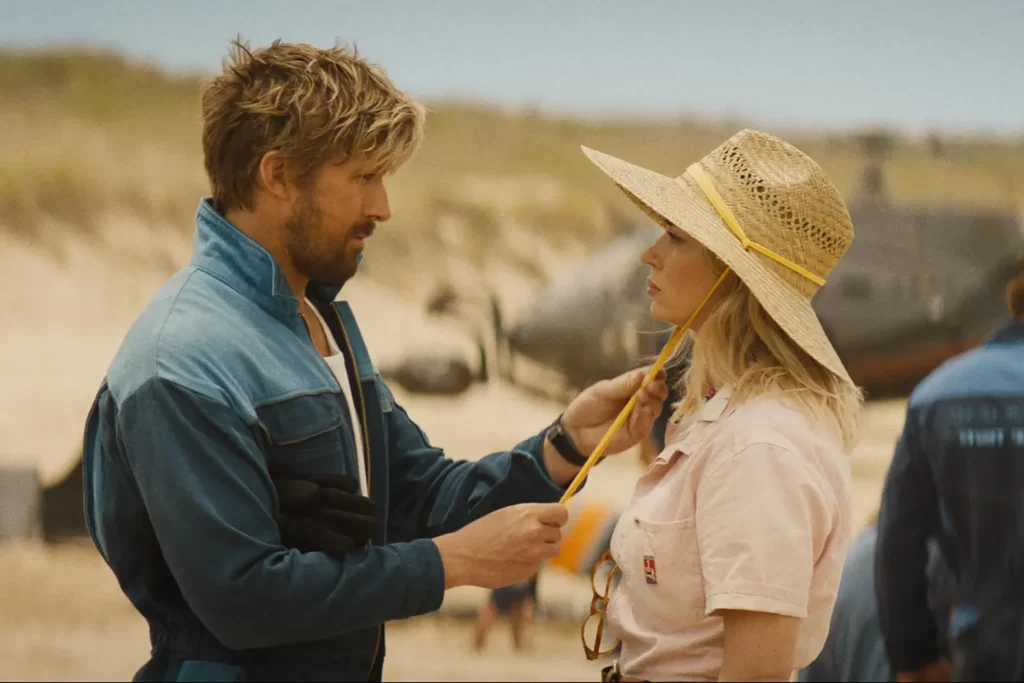
My screening of The Fall Guy was preceded by one of those awkward “Thanks for coming to the theater!” inserts, in which its star (Ryan Gosling) and director (David Leitch) informed the audience that the picture we were about to watch was conceived as a valentine to the stunt community. This, like pretty much everything else in the movie, was an example of overkill, given that its opening scene is a quick-hitting montage of classic stunts (including, if my eyes can be trusted, a glimpse of Leitch’s own Atomic Blonde) while Colt Seavers (Gosling) narrates about stunt performers’ invisible, invaluable contributions to the motion-picture industry. You half-expect the film to pause after each elaborate action sequence so that the doubles can be identified by name and thanked for their service.
So, not subtle. But to a certain sect of nerdy cinephiles (who me?), the themes advanced by The Fall Guy are significant and noble. Much like the most recent Mission: Impossible entry, it mounts an impassioned and convincing argument in favor of tangible, handwoven artistry. The cockamamie plot may manufacture a number of human villains, but the most pernicious force on display here is the blue screen that looms in the background of the film-within-the-film climax. For all its winking modernism, this is essentially a classic movie about good and evil—one where the heroes insist on shooting everything with practical effects while the bad guys proclaim, “We can just fix it in post.”
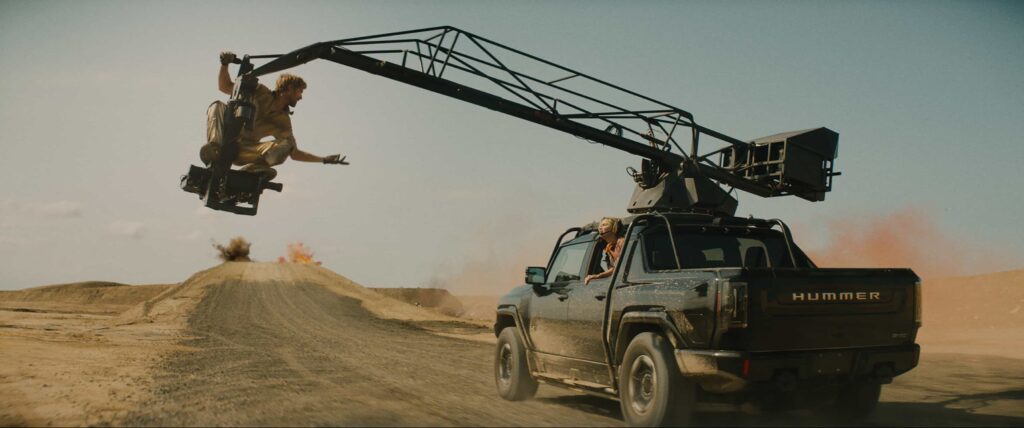
It’s dangerous to impute too much honor to The Fall Guy, whose spirited tribute to the perilous craft of stunt work is animated more by enthusiasm and earnestness than by precision or intelligence. (I should also acknowledge that a number of films which rely heavily on computer effects are, in fact, quite excellent.) Leitch, whose recent credits in addition to Atomic Blonde include Bullet Train and Deadpool 2, tends to be more enraptured with the idea of making gangbusters action pictures than with their actual execution. His labor here is undeniably vigorous; it is also very sloppy. The result is a movie that is entertaining, big-hearted, and kind of a mess.
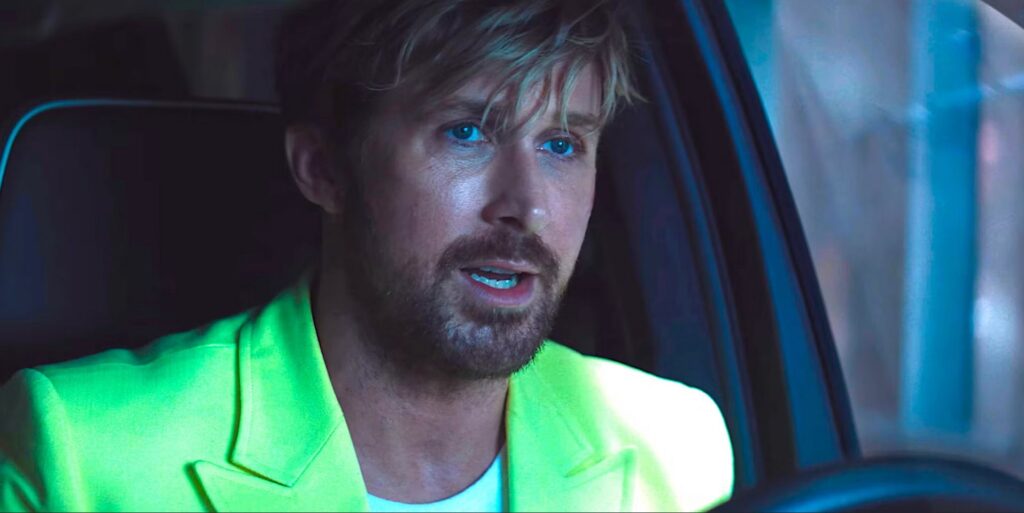
That description also applies to Colt, the down-on-his-luck stuntman whom Gosling imbues with his signature mixture of winking charisma and utter haplessness. The actor is capable of tunneling deep (First Man, Blade Runner 2049), but he’s at his best when he loosens up and hacks away at his own allure. (He earned my Best Supporting Actor vote last year for Barbie, though his crowning achievement remains The Nice Guys.) There’s obvious irony in casting such a beautiful human as a character whose job is to keep his face hidden; despite attempting to camouflage Gosling’s visage behind a scruffy beard, The Fall Guy never really exploits this dissonance. It does, however, make sensible use of his talents, most notably by sticking him in a romantic comedy alongside Emily Blunt.
She plays Jody, a cinematographer-turned-director making her first feature, a sci-fi extravaganza called Metalstorm. Jody and Colt used to be a low-key item before he suffered a figurative and literal fall from grace and then went off the grid, wounding her in the process. The Fall Guy’s plot, which is both needlessly convoluted and entirely irrelevant (the screenplay is by Drew Pearce, drawing vague inspiration from the ’80s TV series starring Lee Majors), contrives to place Colt on Jody’s set as the double for her pretty-boy leading man, Tom Cruise Ryder (Aaron Taylor-Johnson), a vapid prima donna who’s previously anchored such illustrious-sounding titles as “Bad Cop, Good Dog.” What follows is half-courtship, half-humiliation, as Jody unleashes 18 months’ worth of pent-up rage on Colt—did those three takes where she set him on fire suffice, or do they need one more?—even as she inevitably succumbs to his rascally charm.

The chemistry between Gosling and Blunt is axiomatic; there just isn’t enough of it. I don’t mean that the actors, both effortlessly likable and fabulously attractive, struggle to produce sparks of magnetism. To the contrary, their rapport is instantaneous, and they thrust and parry Pearce’s quippy dialogue with inveterate comfort. (Complimenting a stone-faced Jody on her sun hat, Colt hastens to expand his flattery: “You look good in everything, you look good in nothing.”) The Fall Guy is most enjoyable when its leads are bickering and flirting and joshing, which is why its most ravishing scene isn’t a boisterous chase or hectic fight but a split-screen sequence that both separates and unifies the duo, dialing down the explosive volume in favor of precision, rhythm, and wit.
For the most part, however, Leitch is preoccupied with a more robust and chaotic form of excitement. That makes sense, given that the movie is designed to pay homage to old-school actioners, not quirky rom-coms. The problem is that this focus flattens the characters, especially Jody, who despite Blunt’s effervescent appeal is broadly reduced to the role of token love interest, alternately besotted and aggrieved; just because the soundtrack gleefully incorporates KISS’ “I Was Made for Lovin’ You” doesn’t mean Jody should exist primarily as an object of conquest. It’s a part unworthy of a gifted actress who has previously sizzled opposite men in genre pictures as varied as A Quiet Place, Edge of Tomorrow, and The Adjustment Bureau.
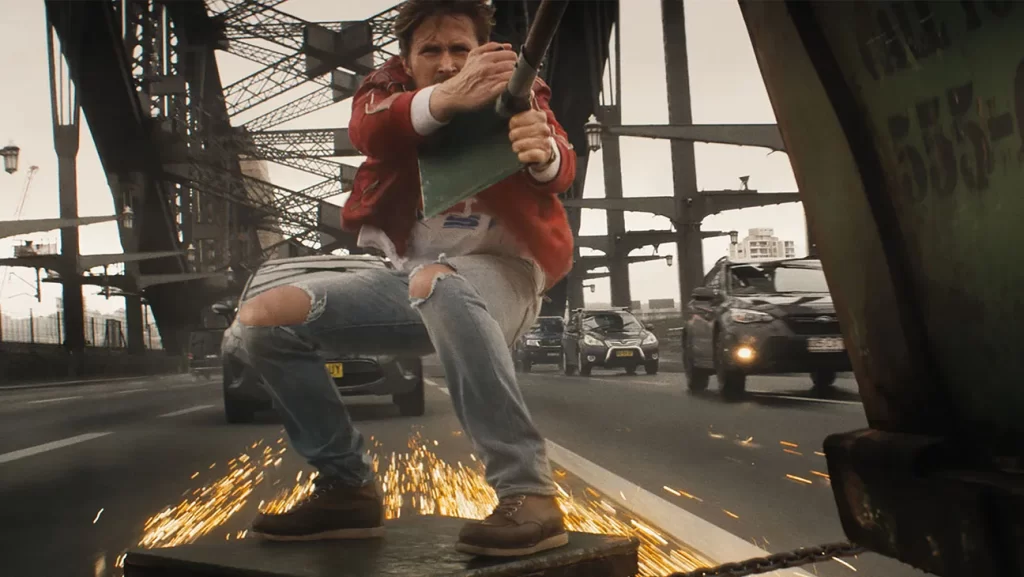
So be it. The raison d’être of The Fall Guy is its eagerness to treat its audience to a spectacle of physical audacity—a parade of improbable derring-do in which the performers risk life and limb for the sake of our entertainment. And on this score, the movie is… pretty good. Leitch’s showmanship is more impressive than astonishing, and his set pieces here never reach the contemporary heights of the John Wick or Mission: Impossible franchises. But he works with variety and brio, keeping things moving without assaulting our eyeballs. The picture’s centerpiece is an extended car-and-truck chase in which Colt and a canine partner (a scene-stealing Australian Kelpie) rampage through the streets of Sydney in pursuit of a MacGuffin; it isn’t amazing, but it’s energetic, and the careening vehicles and dramatic leaps are choreographed with a measure of lucidity. It also contrasts nicely with an earlier sequence at a nightclub, where Colt—clad in a ludicrous neon-yellow coat—lays waste to an armada of foes by brandishing not just his fists and feet, but also wine bottles and a champagne cork.
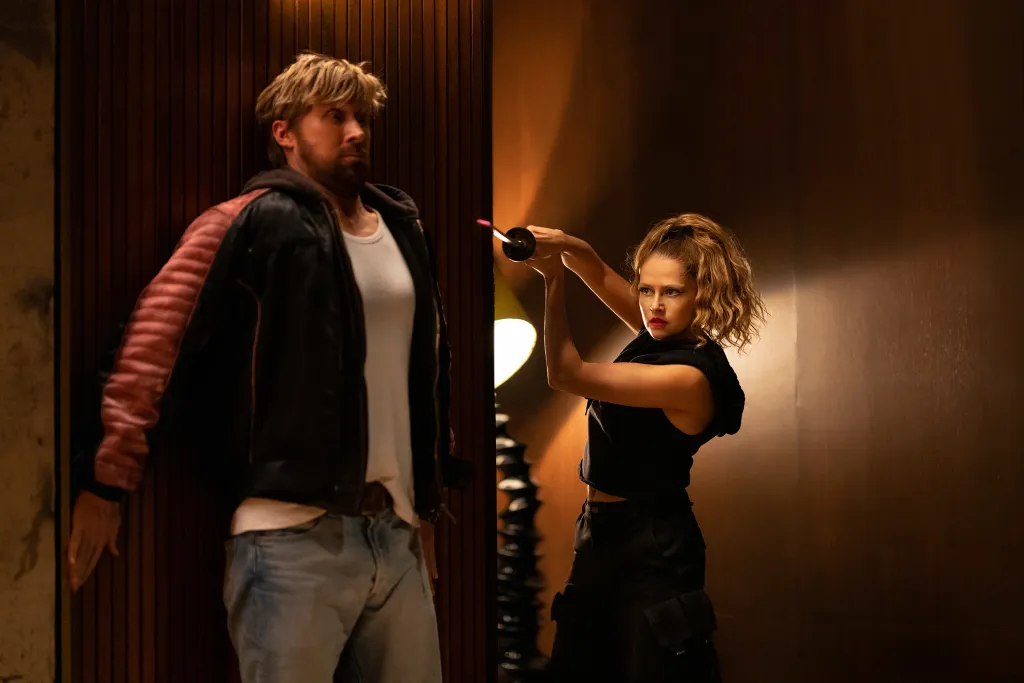
That scene succeeds less for its kinetic thrills—the recent Monkey Man has a leg up in that department—than for its playful tone, which Leitch and Gosling happily maximize. Consider, if you will, the frenzied exchange between Colt and a sword-wielding Metalstorm actress named Iggy (Teresa Palmer) who mistakes him for an intruder:
Colt: “I’m working on Metalstorm too!”
Iggy: “This is Metalstorm one!”
Colt: “I meant also!”
Reader, I guffawed. Yet if The Fall Guy is frivolous in terms of story—often accompanied by a stunt coordinator (Winston Duke) who’s constantly quoting popular action movies, Colt’s entanglement with a criminal conspiracy is as tedious as it is nonsensical—its commitment to blue-collar craftsmanship is deeply serious and sincere. That doesn’t nullify its problems, but it does provide a glimmer of hope that, in our era of deepfakes and green screens, cinema still values daring choreography and forceful physicality. Naturally, early box-office returns have been dispiriting, but I’m not pouring dirt on this mode of filmmaking just yet. After all, if there’s one thing we know about dedicated stunt performers, it’s that they’re always up for doing another take.
Grade: B
Jeremy Beck is the editor-in-chief of MovieManifesto. He watches more movies and television than he probably should.
